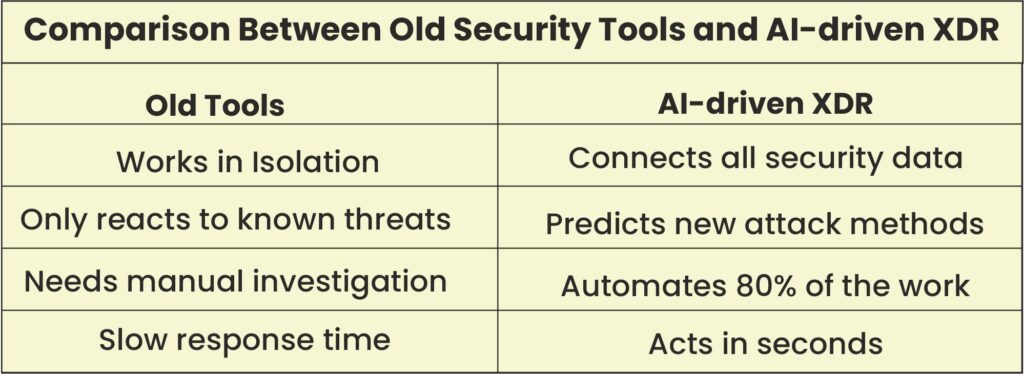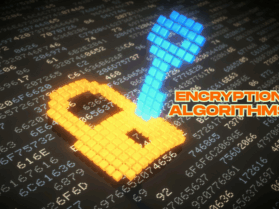Cyber threats are becoming smarter day by day. Hackers do not attack at once- they sneak in, hide, and hit when not expected. Traditional security appliances usually miss such attacks. That is where AI-driven XDR comes in.
By combining AI’s intelligence with XDR’s broad perspective, companies can now detect threats faster. But how does this combo work? Why is it good than traditional security? Let's explain in simple terms.
What is XDR and Why Do We Need It?
XDR, or Extended Detection Response, is a cybersecurity tool. XDR collects data from multiple sources like cloud services, emails, networks, and many more. It uses AI to identify patterns that other individual tools might miss. For example, if a phishing email comes in and someone clicks a link, XDR can track that across email, network traffic, and endpoint activity.
Where Does AI Come In?
AI-driven XDR understands the data; it does not just collect it. Here is how AI makes XDR smarter:
- Spots Hidden Patterns: AI learns what “normal” looks like in your systems and flags weird behavior.
- Predicts Attacks: Instead of waiting for damage, AI warns you before hacker strikes.
- Reduces False Alarms: Humans get overwhelmed by alerts. AI filters out the noise, focusing on real threats.
Without AI, XDR would be like a security camera with no one watching. AI acts as the 24/7 analyst that never sleeps.
How AI-driven XDR Stops Hackers in Real-Life
1. Detecting Sneaky Phishing Attacks
A hacker sends a fake invoice email. Traditional tools might miss it if the link looks clean. But XDR and AI checks:
- Who sent it?
- Is this email style normal for them?
- Are other employees getting similar emails?
If something feels off, AI blocks it before anyone clicks.
2. Stopping Ransomware Before it Spreads
Ransomware locks files and demands payment. Once inside, it spreads fast.
AI-driven XDR notices unusual file encryption attempts and isolates the infected device instantly, saving the whole network.
3. Catching Insider Threats
Not all threats come from outside. Sometimes, employees (accidentally or maliciously) leak data.
AI tracks user behavior. If someone suddenly downloads huge files at 3 am, XDR investigates it.
Why Is This Combo Better Than Old Security Tools?

AI-driven XDR is faster, smarter, and more proactive than old tools. As per reports, 86% of companies say their network and security teams are working together more closely. Nearly half (49%) have even merged these teams either completely or partly to improve collaboration.
Who Needs AI-Powered XDR?
- Businesses with remote workers (More devices mean more risk).
- Companies using cloud apps (Hackers love exploiting weak cloud settings).
- Banks, hospitals, and governments (High-value targets need top-tier security).
Even small businesses get hit by ransomware. XDR and AI is not just for big corporations anymore.
Challenges in AI-driven XDR
- Cost: Advanced AI tools aren’t cheap, but breaches cost more.
- Training Needed: Teams must learn how to use XDR effectively.
- AI isn’t Magic: AI needs human oversight for tricky decisions.
Future of AI-driven XDR
Hackers will keep evolving, and so will AI. Future XDR systems might:
- Auto-fix vulnerabilities before hackers find them.
- Simulate attacks to test defenses.
- Integrate with law enforcement to track cybercriminals globally.
Final Thoughts
Cyberattacks won’t disappear, but AI-driven XDR makes them easier to beat. By combining AI’s brains with XDR’s visibility, businesses can detect, block, and respond to threats faster than ever.
Want Stronger Security?
If you are still depending on old antivirus and firewalls, it is time to explore XDR and AI. The best defense is one that learns and adapts the way hackers do.
Explore SecureITWorld for more such information.
FAQ
Q1. Does XDR use AI?
Answer: Yes, Extended Detection and Response (XDR) frequently leverages AI to process threats more quickly and enhance security by detecting unusual patterns.
Q2. How does AI help with threat detection?
Answer: AI is trained on normal behavior and flags anything unusual, enabling early detection of concealed threats before they can be harmful.
Q3. How do AI detectors detect AI?
Answer: They search for patterns that are overly grammatically perfect text or strange data trails indicating AI-generated material, not human effort.
Also Read:
What is Automated Threat Detection and Response?
Threat Detection and Response (TDR) in Cybersecurity: Explained





